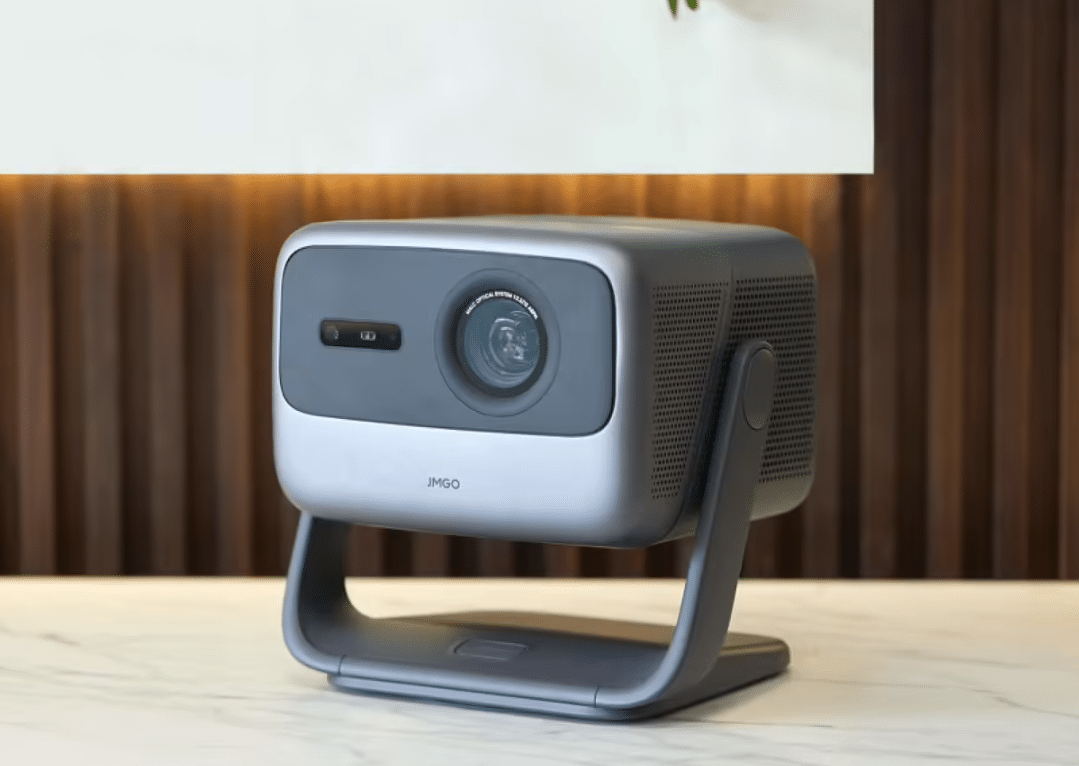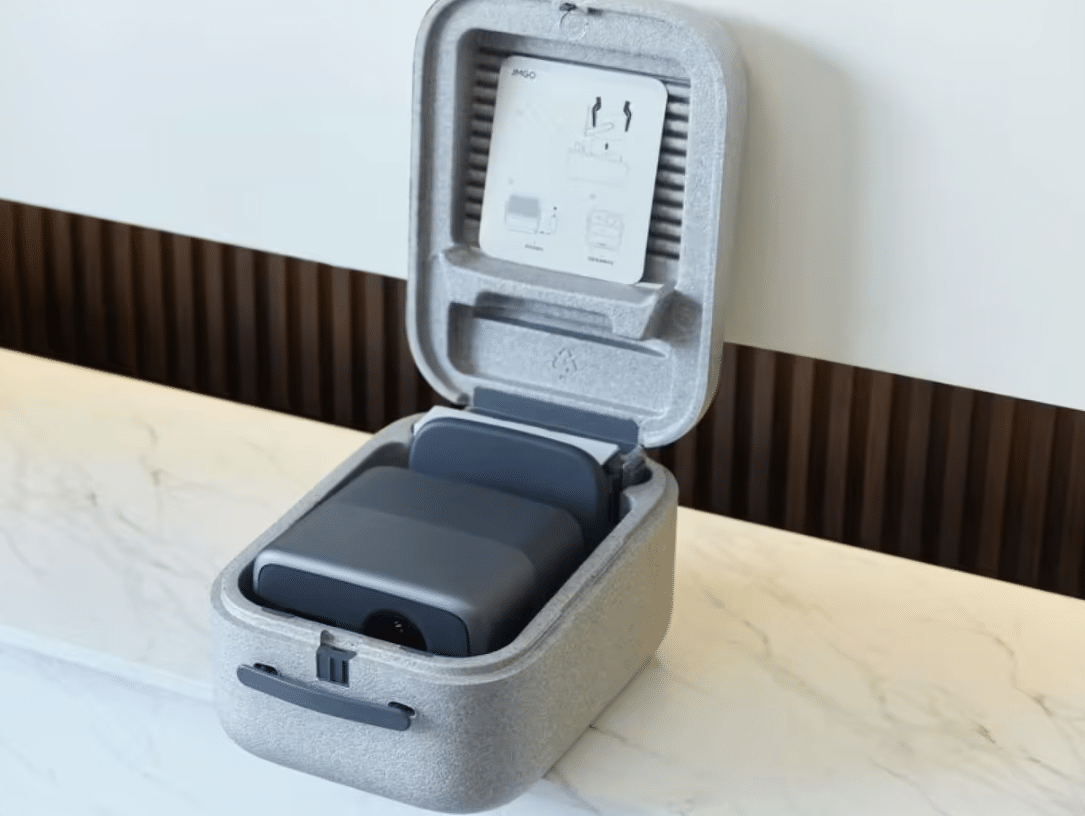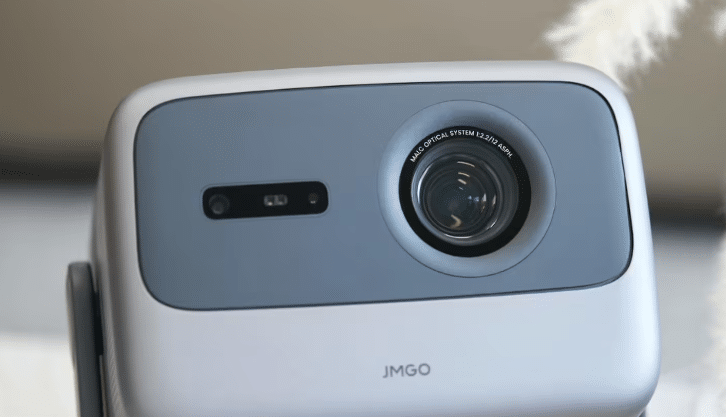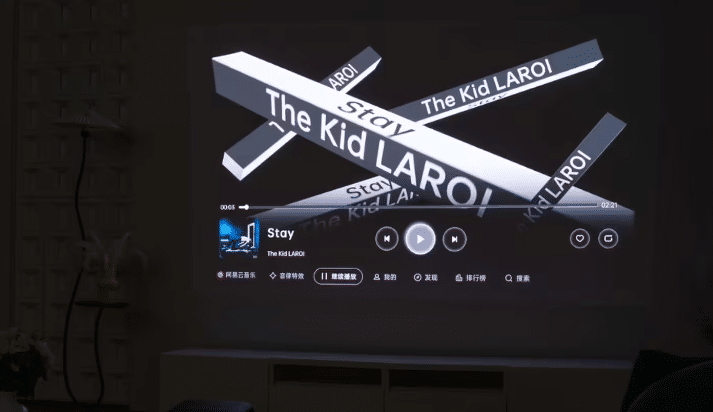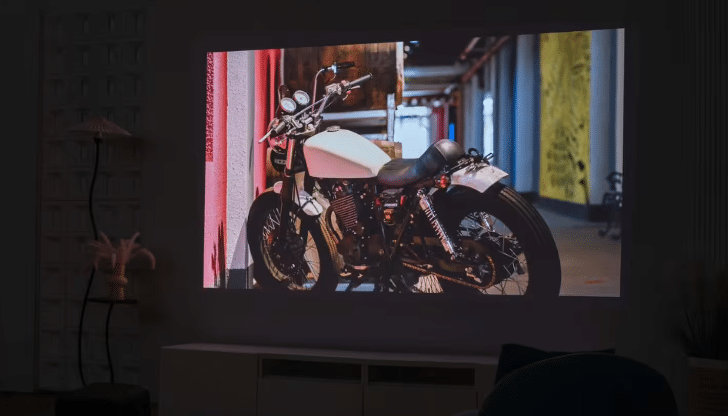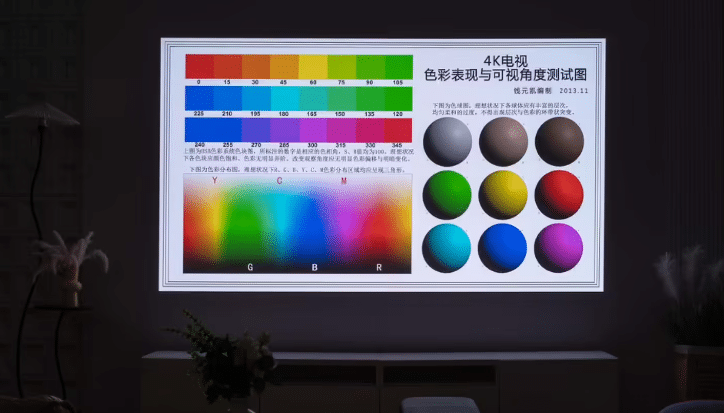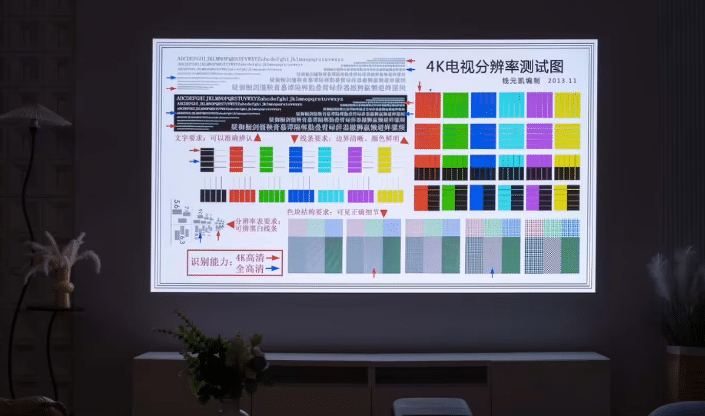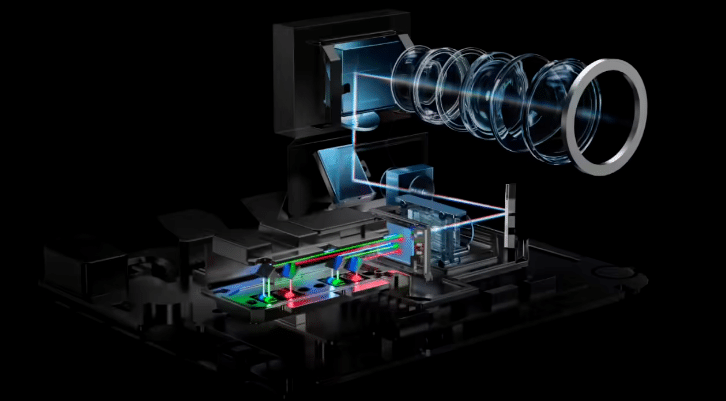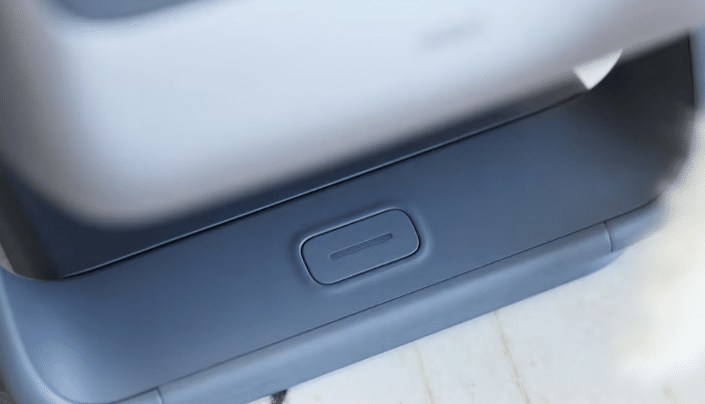JMGO recently launched the JMGO N1S Pro 4K, a new 4K three-color laser projector now available for pre-sale at a price of 6,999 yuan ($975). This upgraded version of the JMGO N1 Pro offers improvements in resolution, speckle reduction, brightness, and more.
In the realm of home projectors, JMGO stands as a leader and a devoted advocate of three-color laser technology. So, what unique experiences does the N1S Pro 4K promise? Claiming to be the “first 4K three-color laser pan-tilt projector in the 6K price range,” what are its distinct advantages? With these inquiries in mind, Gizcoupon obtained this new product and presented a hands-on experience.
Design
The JMGO N1S Pro 4K has two clear design advantages compared to traditional projectors. Let’s explore them.
First, the JMGO N1S Pro 4K maintains an “all-in-one pan/tilt” design, unlike the typical boxy shape of projectors. It has a bracket base below the projector’s main body, allowing 360° horizontal adjustment and 135° vertical rotation. Unlike traditional square projectors that project images only forward, this design eliminates the need for adjusting the projector’s placement for different angles or using books or tripods to change the image height.
Second, the “all-in-one gimbal” of the JMGO N1S Pro 4K offers significant advantages. With the gimbal, users can easily adjust the projector’s pitch by up to 135° vertically, allowing flexible positioning, including projecting onto the ceiling. This is useful for projecting images on the ceiling while in bed or creating unique atmospheres by projecting visuals on walls or the ceiling. Using the JMGO N1S Pro 4K makes these operations simple, like directing a searchlight.
Furthermore, the “all-in-one gimbal” incorporates a “real-time ladder algorithm.” For instance, when adjusting the pitch, the built-in gyroscope detects the angle in real-time, ensuring a square and clear projected image. This combination of the algorithm and physical structure gives it precise control without the need for manual corrections.
Additionally, the JMGO N1S Pro 4K offers four installation methods: front projection, rear projection, ceiling-mounted front projection, and ceiling-mounted rear projection. Thanks to “PTZ” support, it excels in projection adjustment. The second advantage is evident in its outer packaging.
With the increasing demand for portable projectors due to outdoor activities like camping, it features a portable design for its outer packaging. The EPP foam outer packaging is reusable and convenient for carrying. Despite appearances, this packaging design is actually environmentally friendly.
Now, let’s look at the detailed design:
The JMGO N1S Pro 4K has a dark gray color with heat dissipation and speaker openings on both sides. The rear side has large heat dissipation openings. The interface section, including HDMI 2.12, USB1, and a 3.5mm headphone jack, is at the center of the bottom bracket. The DC charging port is on the side of the bottom bracket. At the front, you’ll find the JMGO logo, projection lens, and sensor arranged horizontally with a contrasting color design, wrapped in light gray material. This unique projector image has its charm. Lastly, the accompanying remote control supports near-field voice function.
Display
In May this year, JMGO debated its “three-color laser” technology against its friends’ “super mixed light.” After the debate, JMGO organized the “Open Showdown” event in various offline cities.
JMGO confidently champions “three-color laser” technology, believing it’s the future of high-end projection. Consumers widely embrace it, as seen in Luotu Technology’s first-half 2023 data, where laser projection overtook LED in 4K resolution high-end projection market share.
Projectors have three primary light sources: traditional bulbs, LED, and laser. Traditional bulbs are bright but have short lifespans, unsuitable for home use. LEDs have longer lifespans, compact size, and excellent color, but limited brightness.
Laser sources offer extended life, less light decay, pure colors, higher brightness, low power use, wider color range, and more contrast. They combine traditional bulbs and LEDs advantages, gaining popularity in flagship phones. Laser projection is divided into two routes: monochrome and three-color lasers. JMGO’s friends use “super mixed-light,” combining monochrome lasers and LEDs, seen as transitional by JMGO, who sees three-color lasers as the ultimate solution.
While the projector technology route remains undecided, laser tech has surpassed LEDs as the dominant light source. Another factor is the DMD chip; JMGO N1S Pro 4K features a 0.47 optical chip, a mainstream choice for similar products.
Similar to its competitors, the JMGO N1S Pro 4K achieves 4K resolution through “4K dithering.” When comparing prices to true physical 4K projectors, the value becomes clear. Paying several times more for a true 4K projector with minimal experiential improvement doesn’t make sense for most consumers.
Now, let’s delve into the image quality parameters of the JMGO N1S Pro 4K:
- 110% BT.2020 high color gamut
- 1600:1 contrast ratio
- 2000CVIA brightness
- Brightness uniformity ≥95%
The JMGO N1S Pro 4K features a high color gamut and brightness, producing impressive super HDR effects. It tested image quality and color performance using 4K test pictures and 4K HDR videos.
The JMGO N1S Pro 4K three-color laser projector enhances the color gamut significantly. It makes photos from cameras and mobile phones appear reddish, but this isn’t visible to the naked eye. These photos serve as a reference since they can’t fully capture the JMGO N1S Pro 4K’s true image quality.
The JMGO N1S Pro 4K delivers the expected 4K image quality. It provides a clear 4K display with sharp text and smooth tonal transitions.
When the JMGO N1S Pro 4K displays 4K pictures and 4K HDR videos, its high color gamut of 110% BT.2020 offers a stunning and vibrant color experience. It surpasses Adobe RGB and SRGB standards and approaches the maximum human-visible color range.
To clarify, 110% BT.2020 equals 152% DCI P3 and 149% NTSC. When playing 4K content, the JMGO N1S Pro 4K impresses with vivid colors, especially in pitch-black night conditions where the displayed colors resemble those of a high-quality OLED screen. It’s hard to believe this is a projection screen without special emphasis.
Even in daylight conditions, it maintains good color presentation, although it doesn’t achieve “pure black” by completely eliminating all shades. For instance, the pictures above suit noon photography, and the environment isn’t “completely dark” (the camera slightly reduces exposure during shooting), primarily because of the JMGO N1S Pro 4K’s 2000VVIA brightness.
ANSI
The JMGO N1S Pro 4K does not follow the traditional ANSI brightness standard widely used internationally. Instead, it employs China’s CVIA projection brightness standard, which offers more stringent and standardized guidelines, making it more suitable for three-color laser projectors. Unlike the ANSI method, primarily designed for conventional light bulb sources, CVIA eliminates the possibility of manufacturers manipulating brightness.
Currently, no professional brightness test tools are available, so we won’t conduct a brightness test. Nevertheless, in practice, the JMGO N1S Pro 4K demonstrates impressive brightness. For instance, in bright noon sunlight, you can fully open your living room curtains. The image may seem a bit faded at this point but remains “usable.”
However, it’s essential to understand that if you intend to watch during the day without closing the curtains or prefer a projector over a TV for daytime viewing, this may not be effective. This limitation applies to all home projectors. Projectors are designed not to replace TVs but to enhance viewing experiences beyond what TVs can offer.
Now, addressing the “speckle” issue of concern to many. The laser’s coherence leads to the “speckle” effect, making the image look noisy, somewhat resembling a mobile phone’s “rag screen.” JMGO tackles this with LSR dynamic speckle elimination technology, claiming to achieve 97% speckle reduction, an improvement over the previous generation’s 96%.
Despite the 1% difference, according to Xu Zuyan, a Chinese Academy of Engineering academician, the speckle, down-tuned to meet National Standards Committee criteria, is less than 3% and remains undetectable to the naked eye. In my experience, the “speckle” effect on the JMGO N1S Pro 4K is nearly invisible to the naked eye. Although it’s still faintly present, it won’t affect your overall viewing experience. Only if you scrutinize it, like examining the edges of white text, might you notice some “rainbow patterns.” However, I believe few people will do this. For most consumers, if not specifically pointed out, they are unlikely to notice the “speckle” issue during their movie viewing.
Audio
The audio part of JMGO N1S Pro 4K features 2*10W Dynaudio speakers, officially recognized as “palace-level Dynaudio HiFi sound quality,” with bass reaching as low as 45Hz. This makes JMGO N1S Pro 4K the sole brand among projection manufacturers bold enough to standardize bass dive parameters.
What stands out most about JMGO N1S Pro 4K’s audio is its remarkably balanced three-frequency performance, encompassing low-frequency drum elements, high-frequency strings, and mid-to-high-frequency vocals. The sound boasts clear layers and a distinct presence that seems to emanate from all directions, rather than a specific area. In terms of the overall audio experience, JMGO N1S Pro 4K delivers performance that is commensurate with its price.
Interaction
The JMGO N1S Pro 4K boasts the MT9 series flagship chip. It doesn’t have an official model, but it packs 4+64GB storage, which is more than sufficient for a projector. In our tests at Gizcoupon, we found that the JMGO N1S Pro 4K offers a smooth system interaction experience. However, the absence of WiFi6 support raises questions. Can upgrading to WiFi6 be done without significantly increasing costs?
Now, let’s delve into the interactive aspect.
The JMGO N1S Pro 4K features the intriguing “Bonfire OS” system. Officially, this system was a collaboration with Frog, Apple’s renowned design company. A game engine builds it, delivering a fresh visual and interactive experience. When you power on the JMGO N1S Pro 4K, it greets you not with the traditional TV UI’s information waterfall style but with a brand new “borderless” interface. As depicted above, “Bonfire OS” offers a dynamic desktop brimming with personalization and quick access to high-frequency functions.
This dynamic desktop can also change with the passing of time. “Bonfire OS” also provides dedicated spaces for movies, music, atmosphere, and rhythm.
Consider “Music Space,” for instance. Under this interface, the JMGO N1S Pro 4K provides an immersive music listening experience, displaying different background videos and lyric effects in sync with the music’s tempo – a truly fascinating feature. It also integrates with third-party platforms like NetEase Cloud Music and Kugou Music.
OS
“Rhythm Space” is another mode in the N1S Pro 4K projector. In this mode, it offers various Buddhist and Zen functions, such as wake-up, hypnosis, nap, white noise, and more. Additionally, it provides comprehensive content services like images, music, alarms, and message broadcasts. The “atmosphere space” supports one-click switching on the projection end and allows custom wall atmospheres via the JMGO Control App.
JMGO intends to encourage users to use the “projection” function through this innovative UI design. They want users to seamlessly integrate the product into their digital lives, making it a natural part of their home, like a “digital campfire.”
The N1S Pro 4K offers various features to enhance functionality. It supports real-time gradient effects, focus adjustment, brightness adaptation, wall color correction, intelligent eye protection, automatic obstacle avoidance/screen alignment, and screen memory.
For instance, when the system detects a person in front of the projector, it quickly turns off the projector and issues an intelligent eye protection reminder. Adaptive brightness intelligently adjusts its brightness according to ambient light, eliminating the need for frequent manual adjustments. Finally, the wall color adaptive function guarantees precise color correction, even when projecting onto colored walls, thanks to advanced algorithms.
Verdict
JMGO’s release of the N1S Pro 4K demonstrates their confidence in popularizing the “three-color laser.” They actively promote it. In the past, three-color laser projectors often cost over RMB 10,000. However, in recent years, products like the JMGO N1S Pro 4K have entered the market, making it more affordable for consumers.
As the future high-end projection technology, consumers can increasingly know and understand the “three-color laser,” encouraging them to try it. This aligns with the goals of its advocates. The JMGO N1S Pro 4K stands out in its price range due to its high-quality color performance, achieved through a high color gamut, brightness, and contrast.
The JMGO N1S Pro 4K offers advantages like a “gimbal” and portability in the “three-color laser” category, ensuring stability in any environment with adjustable angles and free hovering. It is the ideal choice for users who want high image quality, brightness, and ease of use. The JMGO N1S Pro 4K is the first 4K three-color laser pan-tilt projector under 6K.
Read Also: XGIMI Play 3 PTZ Projector Goes on Sale for 1,999 Yuan
